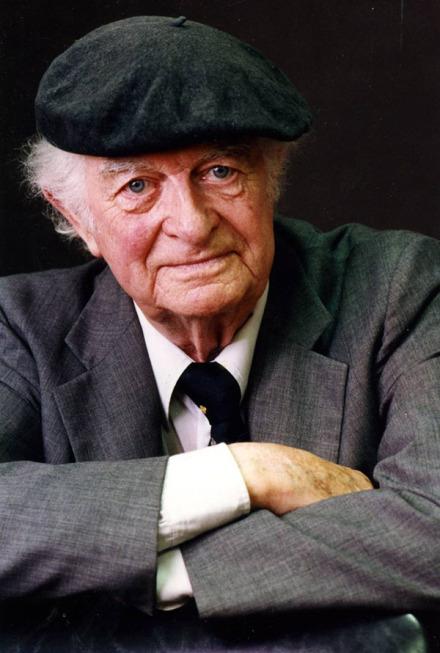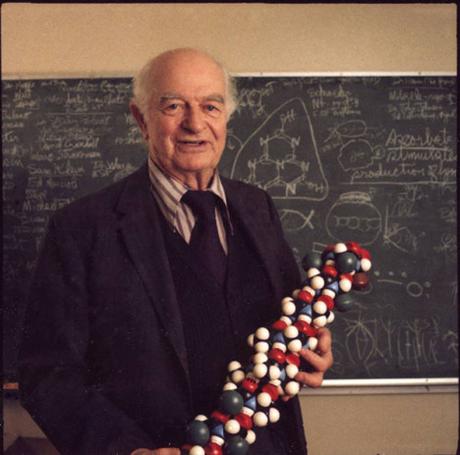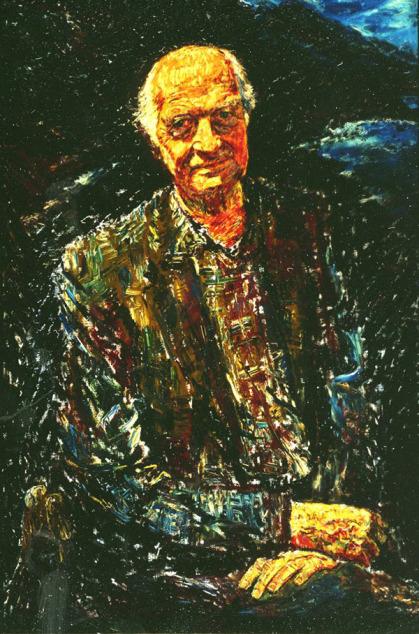 Linus Pauling, 1988. Image credit: Albert Dadian
Linus Pauling, 1988. Image credit: Albert DadianThe Ava Helen and Linus Pauling Papers at Oregon State University Libraries include more than 3,000 newspaper clippings that focus on Linus Pauling as a primary subject. Among these, 170 extant clippings are devoted to remembering Pauling in the days and weeks following his death on August 19, 1994. In today’s post, we present a few anecdotes that we came across in reviewing this content, snapshots of a remarkable life.
Keay Davidson, San Francisco Examiner
Professor Pauling has brilliant blue eyes and an infectious grin. He wore a dusty blue beret and always stood to extend an enthusiastic, wrinkled hand to reporters and just plain admirers.
Former students loved to recall his lectures, which have been compared, for sheer entertainment value, to those of the other great showman of modern American science – the late physicist Richard Feynman. In his 1985 autobiography, “Radiant Science, Dark Politics,” former Berkeley scientist Martin D. Kamen fondly recalled a Pauling lecture of the 1930s: “He bounded into the room, already crowded with students eager to hear the Great Man, spread himself over the seminar table next to the blackboard and, running his hands through an unruly shock of hair, gestured to the students to come closer.”
“I remember one of my best friends at Caltech, when we were sitting in a chemistry lecture, looking at me and saying, ‘I don’t know what is more fun – watching Pauling or watching you watching Pauling,” Art Robinson, a former colleague, recalled.
“Linus Pauling Dies at 93,” August 20, 1994
Jeff Gottlieb, San Jose Mercury News
“He’s really a compulsive worker,” said Linus Pauling Jr, a retired psychiatrist. “He had built-in energy. Most people when they leave the office at the end of the day they quit working. He would bring stuff home and he would work. It was really the only thing he did.”
Matthew Meselson, a biochemistry professor at Harvard who was one of the last graduate students to train under Pauling, recalled a story his teacher told him. The great German mathematician Karl Friedrich Gauss, Pauling said, was asked why he was so great in his field. “I don’t know,” Gauss replied, “but maybe it’s because I never do anything else.”
Pauling took the insights he learned in quantum mechanics and brought them to chemistry with his theory of the chemical bond. “He was this country’s first and best ever structural chemist,” [Roald] Hoffmann said. “He pioneered several techniques in this country and he put this country in the leadership of chemistry through his work.”
“Nobel Winner Linus Pauling Dies of Cancer,” August 20, 1994
 Linus Pauling at the Grand Canyon, circa 1947
Linus Pauling at the Grand Canyon, circa 1947Robin McKie, The Times (London)
All of [his] achievements were made in typical Pauling style – involving displays of astonishing intuition, a phenomenal memory and a willingness to take great intellectual risks. As historian Horace Judson states in his history of modern biology, The Eighth Day of Creation, “Linus Pauling had energy, inventiveness, showmanship and genius enough for a consortium.”
“Linus Pauling: The Century’s Greatest Chemist,” August 21, 1994
Elizabeth Weise, Associated Press
“I consider him to be certainly the most influential chemists of the century, but he really belongs among the most extraordinary scientists of all time,” said Dr. Henry Taube, professor emeritus of chemistry at Stanford. “In a sense he put structural chemistry on the map. He made some of the most important contributions to this field, and his ideas on the structure of proteins stand today,” Taube said.
Dr. Max Perutz, founder of the molecular biology laboratory at Cambridge, England, called Pauling’s 1939 book The Nature of the Chemical Bond a revelation. “I think that’s what he should be remembered for. As a student, chemistry was something you learned by heart but you didn’t understand. Linus Pauling’s book made me and countless others understand chemistry for the first time.”
Pauling was best known in the past two decades for his belief that large doses of ascorbic acid, or vitamin C, could protect people from colds, cancer and cardiovascular disease, as well as extend the lifespan for decades. Despite skepticism over his claims, Pauling retained the respect of his fellow scientists [Horace] Judson said. “There are plenty of scientists who say ‘This has been disproven but if Linus says it’s true, I’m going to take my vitamin C every morning anyway,” Judson said.
“Pauling Chartered Life Itself,” as published in the Santa Cruz Sentinel, August 21, 1994
 Pauling holding a model of the alpha helix, circa 1980s
Pauling holding a model of the alpha helix, circa 1980sRichard Severo, The New York Times
In the early 1950s, Dr. James D. Watson and Sir Francis Crick were constantly looking over their shoulders at the body of the research of Linus Pauling with a mixture of admiration and apprehension. Dr. Watson and Sir Francis were at the time feverishly trying to determine that structure that is crucial to the construction of all living cells – DNA – and Dr. Pauling was pursuing the same goal.
Writing years later in The Double Helix, a book about the discovery, Dr. Watson described Dr. Pauling’s presentation of work, showing, in part, the helical structure of proteins. The passage reveals not only the high esteem in which Dr. Pauling was held by his colleagues but also the intense envy he sometimes engendered.
“Pauling’s talk was done with his usual flair,” Dr. Watson wrote. “The words came out as if he had been in show business all his life. A curtain kept his model hidden until near the end of his lecture, when he proudly unveiled his latest creation. Then, with his eyes twinkling, Linus explained the specific characteristics…that made his model uniquely beautiful. This show, like all of his dazzling performances, delighted the younger students in attendance. There was no one like Linus in all the world. The combination of his prodigious mind and his infectious grin was unbeatable. Several fellow professors, however, watched this performance with mixed feelings. Seeing Linus jumping up and down on the demonstration table and moving his arms like a magician about to pull a rabbit out of his shoe made them feel inadequate. If only he had shown a little humility, it would have been so much easier to take!”
“Linus C. Pauling, Pioneering Chemist, Voice for Peace and Nobel Laureate, Dies at 93,” August 21, 1994
Los Angeles Times
Pauling was a very compassionate individual, by all accounts, and his sympathies instantly sprang to those who had been made to suffer for their political beliefs. “He once hired a lab director,” [James] Bonner said, “whose sole credential for the job was the fact that he had been fired from his previous post for citing the 5th Amendment on his own behalf during some anti-Communist hearings. The man was not a good choice for the job, but still Linus stuck by him.”
Pauling’s greatest strength, said many who knew him through the years, was also his Achilles’ heel: a supreme, unshakable confidence in the correctness of his own judgments. “When he was right, which was more often than not,” said one longtime friend, “he was very, very right. But when he was wrong, which he also was from time to time, there was no way to get him to see it, or to compromise, or to make any kind of concession. This attitude frankly rubbed a lot of people the wrong way.”
In the end, such foibles amount to little when compared to the achievements of Pauling’s remarkable contributions to science and society. “He had one of the most original, creative minds of any scientist in the 20th century,” said Norman Davidson, a longtime colleague. “There is no doubt that he will be the preeminent chemist of this century.”
“A Flamboyant Scientist’s Legacy,” uncredited staff writer, August 21, 1994
 Oil painting of Linus Pauling by Giovanella, circa 1970s
Oil painting of Linus Pauling by Giovanella, circa 1970sDavid F. Salisbury, Stanford Campus Report
Henry Taube recalls vividly the first time he met Linus Pauling. It was at a seminar held in 1938 at the University of California-Berkeley. “Pauling was already famous,” the Stanford chemistry professor and Nobel laureate says. Following a brilliant lecture, Pauling handled all the questions put to him so readily and deftly that a fellow scientist was moved to remark that Pauling must have a pipeline to God and to jokingly propose that he should be called Pope Linus I. “Pauling responded by informing the person that there had already been several Pope Linuses, so he couldn’t be the first. However, he didn’t object to the fitness of the designation,” Taube says.
“He had a great sense of humor. It was not canned, but spontaneous,” [Harden] McConnell says. He points to a humorous scientific paper that Pauling published about a commercial product that was supposed to combat odors. Because his analysis showed that the product was mostly formaldehyde, Pauling concluded that it worked by embalming people’s noses.
“Colleagues Recall Multifaceted Scientist Pauling,” August 24, 1994
Alexander Rich, Nature
Linus Pauling was widely honored. In addition to two Nobel Prizes he received over 50 medals and awards from a great variety of organizations, and almost as many honorary degrees from universities. The esteem with which he was regarded was vividly illustrated to me in 1951 when, as a postdoctoral fellow of Pauling’s, I visited Albert Einstein in Princeton. Einstein’s comment to me was “Ah, that man is a real genius!”
“Linus Pauling (1901-1994), September 22, 1994
